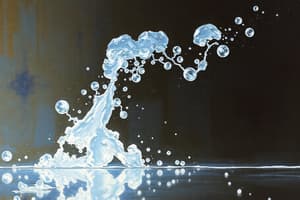Podcast
Questions and Answers
How does the addition of a common ion, such as $F^-$, to a solution containing $HF$, affect the equilibrium, and how is this explained by Le Chatelier's Principle?
How does the addition of a common ion, such as $F^-$, to a solution containing $HF$, affect the equilibrium, and how is this explained by Le Chatelier's Principle?
- The equilibrium shifts to the right, increasing the ionization of HF, in accordance with Le Chatelier's Principle.
- The equilibrium remains unchanged as the common ion does not affect weak acid equilibrium.
- The equilibrium initially shifts to the right, but then returns to its original state due to the buffering capacity of the solution. (correct)
- The equilibrium shifts to the left, reducing the ionization of HF, as the system attempts to relieve the stress of added product ($F^-$), as stated by Le Chatelier's Principle.
A buffer solution contains a weak acid, $HA$, and its conjugate base, $A^-$. What is the primary mechanism by which this solution resists changes in pH when a strong acid, $H_3O^+$, is added?
A buffer solution contains a weak acid, $HA$, and its conjugate base, $A^-$. What is the primary mechanism by which this solution resists changes in pH when a strong acid, $H_3O^+$, is added?
- The hydronium ions react directly with water molecules, neutralizing the added acid.
- The weak acid, $HA$, donates protons to neutralize the added acid, forming water.
- The buffer solution undergoes a phase change that absorbs the added acid without altering the pH. (correct)
- The conjugate base, $A^-$, reacts with the added hydronium ions to form the weak acid, $HA$, thus consuming the added acid.
$HF$ and $NaF$ are combined in a solution. Which statement accurately describes their respective roles in creating a buffer solution?
$HF$ and $NaF$ are combined in a solution. Which statement accurately describes their respective roles in creating a buffer solution?
- $HF$ acts as a weak base, and $NaF$ provides its conjugate acid, $Na^+$.
- $HF$ acts as a weak acid to neutralize added bases, and $NaF$ provides the conjugate base, $F^-$, to neutralize added acids.
- $HF$ and $NaF$ work synergistically to create a saturated solution that resists any pH change. (correct)
- $HF$ acts as a strong acid, and $NaF$ acts as a strong base, neutralizing each other.
Ammonia, $NH_3$, reacts with $HCl$ to form ammonium chloride, $NH_4Cl$. How does this mixture function as a buffer solution?
Ammonia, $NH_3$, reacts with $HCl$ to form ammonium chloride, $NH_4Cl$. How does this mixture function as a buffer solution?
What is the fundamental relationship described by the Henderson-Hasselbalch equation, and why is it useful in buffer calculations?
What is the fundamental relationship described by the Henderson-Hasselbalch equation, and why is it useful in buffer calculations?
In a titration, how does the equivalence point differ from the end point, and what factor most critically affects their proximity?
In a titration, how does the equivalence point differ from the end point, and what factor most critically affects their proximity?
When determining pH at various points in a titration, under what circumstances would you use a reaction table in units of moles (or mmol) versus a reaction table using Molarity (or mM)?
When determining pH at various points in a titration, under what circumstances would you use a reaction table in units of moles (or mmol) versus a reaction table using Molarity (or mM)?
What is the significance of the solubility product constant, $K_{sp}$, in the context of solubility equilibria?
What is the significance of the solubility product constant, $K_{sp}$, in the context of solubility equilibria?
How is molar solubility defined, and what distinguishes it from general solubility?
How is molar solubility defined, and what distinguishes it from general solubility?
Given the $K_{sp}$ of a sparingly soluble salt, $MX$, how can its molar solubility, $s$, be determined using an ICE table?
Given the $K_{sp}$ of a sparingly soluble salt, $MX$, how can its molar solubility, $s$, be determined using an ICE table?
How does the presence of a common ion affect the solubility of a salt, and what principle explains this phenomenon?
How does the presence of a common ion affect the solubility of a salt, and what principle explains this phenomenon?
Apart from the common ion effect, which of the following factors can influence the solubility of a salt, and how do they typically affect it?
Apart from the common ion effect, which of the following factors can influence the solubility of a salt, and how do they typically affect it?
How does pH affect the solubility of salts containing ions that are conjugate acids or bases of weak acids or bases, and provide an example to illustrate this effect?
How does pH affect the solubility of salts containing ions that are conjugate acids or bases of weak acids or bases, and provide an example to illustrate this effect?
Under what condition does precipitation occur in a solution, and how does the reaction quotient, $Q$, relate to the solubility product, $K_{sp}$, in determining whether a precipitate will form?
Under what condition does precipitation occur in a solution, and how does the reaction quotient, $Q$, relate to the solubility product, $K_{sp}$, in determining whether a precipitate will form?
How does the common ion effect influence the solubility of $AgCl$ in a solution already containing $NaCl$?
How does the common ion effect influence the solubility of $AgCl$ in a solution already containing $NaCl$?
Which factor has the least influence on the $K_{sp}$ value of a sparingly soluble salt?
Which factor has the least influence on the $K_{sp}$ value of a sparingly soluble salt?
In a titration of a weak acid with a strong base, at what point is the pH of the solution equal to the $pK_a$ of the weak acid?
In a titration of a weak acid with a strong base, at what point is the pH of the solution equal to the $pK_a$ of the weak acid?
Which of the following indicators would be most suitable for a titration where the equivalence point is known to be at a pH of 5.2?
Which of the following indicators would be most suitable for a titration where the equivalence point is known to be at a pH of 5.2?
How does an increase in temperature generally affect the solubility of a gas in water?
How does an increase in temperature generally affect the solubility of a gas in water?
For the dissolution of a certain salt, $\Delta H > 0$. How will increasing the temperature affect the $K_{sp}$ and the solubility of the salt?
For the dissolution of a certain salt, $\Delta H > 0$. How will increasing the temperature affect the $K_{sp}$ and the solubility of the salt?
What is the primary reason that the $pH$ of a buffer solution changes only slightly upon addition of a small amount of strong acid or base?
What is the primary reason that the $pH$ of a buffer solution changes only slightly upon addition of a small amount of strong acid or base?
Consider a buffer solution made of acetic acid ($CH_3COOH$) and sodium acetate ($CH_3COONa$). If a small amount of hydrochloric acid ($HCl$) is added, what reaction occurs to maintain the buffer's $pH$?
Consider a buffer solution made of acetic acid ($CH_3COOH$) and sodium acetate ($CH_3COONa$). If a small amount of hydrochloric acid ($HCl$) is added, what reaction occurs to maintain the buffer's $pH$?
Which scenario best describes the application of the common ion effect in controlling the solubility of a metal hydroxide, $M(OH)_2$?
Which scenario best describes the application of the common ion effect in controlling the solubility of a metal hydroxide, $M(OH)_2$?
How does the presence of a complexing agent, such as ammonia ($NH_3$), affect the solubility of $AgCl$, and what is the underlying mechanism?
How does the presence of a complexing agent, such as ammonia ($NH_3$), affect the solubility of $AgCl$, and what is the underlying mechanism?
What conditions favor precipitation in a solution containing $PbCl_2$, given that the dissolution of $PbCl_2$ is an endothermic process?
What conditions favor precipitation in a solution containing $PbCl_2$, given that the dissolution of $PbCl_2$ is an endothermic process?
If a solution containing $Ag^+$ ions is mixed with a solution containing $Cl^-$ ions, and the ion product $Q$ is much greater than the $K_{sp}$ of $AgCl$, what will occur?
If a solution containing $Ag^+$ ions is mixed with a solution containing $Cl^-$ ions, and the ion product $Q$ is much greater than the $K_{sp}$ of $AgCl$, what will occur?
How does the molar solubility of $CaF_2$ change if the $pH$ of the solution is significantly decreased?
How does the molar solubility of $CaF_2$ change if the $pH$ of the solution is significantly decreased?
Flashcards
Common Ion Effect
Common Ion Effect
The reduction in solubility or ionization of a substance when a solution already contains a common ion.
Le Chatelier's Principle
Le Chatelier's Principle
A principle stating that if a change of condition is applied to a system in equilibrium, the system will shift in a direction that relieves the stress.
Buffer Solution
Buffer Solution
A solution that resists changes in pH when small amounts of acids or bases are added; contains both an acid and its conjugate base.
HF and NaF as a Buffer
HF and NaF as a Buffer
Signup and view all the flashcards
NH3 and HCl as a Buffer
NH3 and HCl as a Buffer
Signup and view all the flashcards
Titration
Titration
Signup and view all the flashcards
Titrant
Titrant
Signup and view all the flashcards
Equivalence Point
Equivalence Point
Signup and view all the flashcards
End Point
End Point
Signup and view all the flashcards
Indicator
Indicator
Signup and view all the flashcards
Solubility Product Constant (Ksp)
Solubility Product Constant (Ksp)
Signup and view all the flashcards
Molar Solubility
Molar Solubility
Signup and view all the flashcards
Common Ion Effect on Solubility
Common Ion Effect on Solubility
Signup and view all the flashcards
Factors Affecting Solubility
Factors Affecting Solubility
Signup and view all the flashcards
Precipitation
Precipitation
Signup and view all the flashcards
Study Notes
Common Ion Effect
- The common ion effect occurs when a solution contains two substances sharing a common ion.
- The common ion effect reduces the solubility or ionization of one of the substances.
- According to Le Chatelier's Principle, adding more of a product (like a common ion) shifts the reaction toward the reactants side.
- For a solution of HF (HF + H2O ⇌ H3O+ + F-), adding NaF introduces F-, which shifts the reaction to the left.
Buffer Solutions
- Buffer solutions resist changes in pH upon addition of small amounts of acids or bases.
- Buffers contain both an acid and its conjugate base (or a base and its conjugate acid).
- The base component of the buffer reacts with added acid, and the acid component reacts with added base, maintaining a stable pH.
HF and NaF as a Buffer
- HF is a weak acid and NaF provides the conjugate base, F-.
- HF neutralizes added bases while F- neutralizes added acids.
- The combination of HF and NaF keeps the pH of the solution stable.
NH3 and HCl as a Buffer
- NH3 (ammonia) is a weak base that, when reacted with HCl, forms NH4+, the conjugate acid.
- NH3 can react with added acids, with NH4+ reacting with added bases to resist pH changes.
Henderson-Hasselbalch Equation
- The Henderson-Hasselbalch equation calculates the pH of a buffer.
- pH of a buffer also can be calculated by determining the moles of conjugate acid and base, then using volumes to calculate concentrations.
- An ICE table can then be set up to solve for E concentrations and calculate pH.
- The Henderson-Hasselbalch (H-H) equation offers a faster alternative to the steps above.
Titration Terminology
- Titration is an experimental method where one solution is slowly added to another until the reaction is complete, often to find the concentration of a substance.
- Titrant is the solution added from a burette during titration.
- The equivalence point is when the amount of acid equals the amount of base, indicating a complete reaction.
- The end point is when an indicator changes color, signifying the titration is complete, which should be close to the equivalence point.
- Indicators are substances that change color at a certain pH, used to show the end of a titration.
Titration Curves
- Strong acid, strong base titration is shown in Figure 17.3.
- Weak acid, strong base titration shown in Figure 17.4.
- Strong acid, weak base titration is shown in Figure 17.6.
Reaction Tables for Titration Calculations
- Use an ICE table with molarities for a solution containing only a weak base or weak acid due to their equilibrium nature, done at the start of titration and at the equivalence point.
- Use a reaction table in units of moles at every other point in the titration where there is a mixture of weak acid/base and strong base/acid. This is due to the reaction going to completion because of the strong acid/base present.
- An SRFC table can be used.
Solubility Product Constant
- The solubility product constant, Ksp, indicates how soluble a compound is in water.
- Ksp is the product of the concentrations of the ions in a saturated solution, each raised to the power of its coefficient in the balanced equation.
Molar Solubility
- Molar solubility refers to the number of moles of a compound that can dissolve in 1 liter of water before the solution becomes saturated.
Relationship Between Ksp and Molar Solubility
- Ksp and molar solubility can be calculated from each other using an ICE table.
- Molar solubility equals 'x' in the ICE table, allowing Ksp to be calculated.
- Ksp can also be used to solve for 'x' in the ICE table, giving the molar solubility.
Common Ion Effect on Salt Solubility
- The common ion effect reduces the solubility of a salt.
- If the solution already contains one of the salt's ions, the salt's solubility decreases because the solution cannot hold as much of the same ion.
- Adding the ion shifts the equilibrium towards the reactant side (undissolved salt) due to Le Chatelier’s principle.
Factors Affecting Salt Solubility
- Temperature increases solubility, but it's not always applicable.
- Changes in pH impacts the solubility of salts containing acidic or basic ions, where pH affects the amount of the ion in solution.
Precipitation
- Precipitation occurs when the product of ion concentrations in a solution exceeds Ksp (Q > Ksp).
- The reaction quotient, Q, helps determine if precipitation will happen.
Studying That Suits You
Use AI to generate personalized quizzes and flashcards to suit your learning preferences.
Related Documents
Description
Explanation of the common ion effect and buffer solutions. The common ion effect reduces solubility when a solution contains two substances with a common ion. Buffer solutions resist pH changes by containing an acid and its conjugate base.




